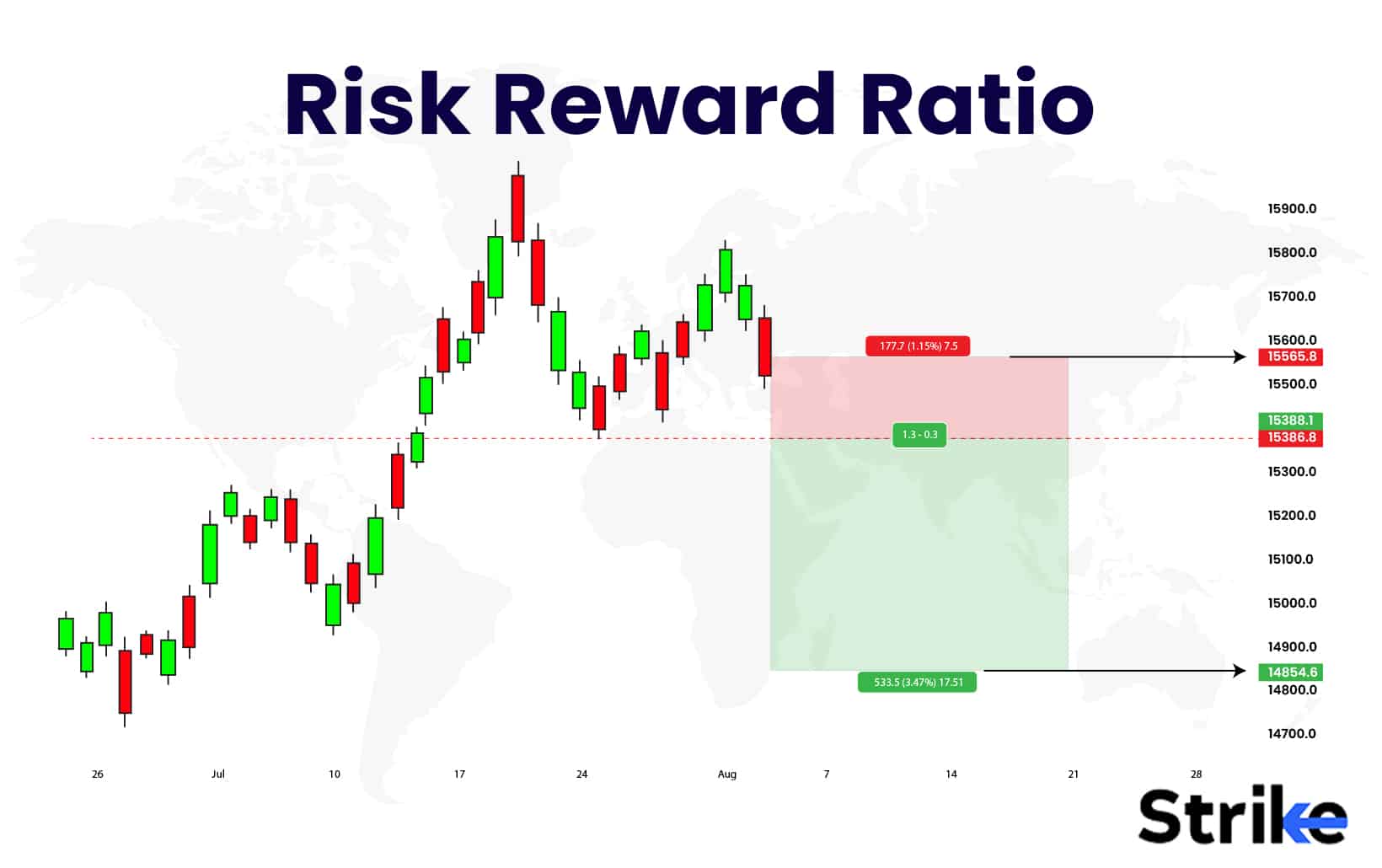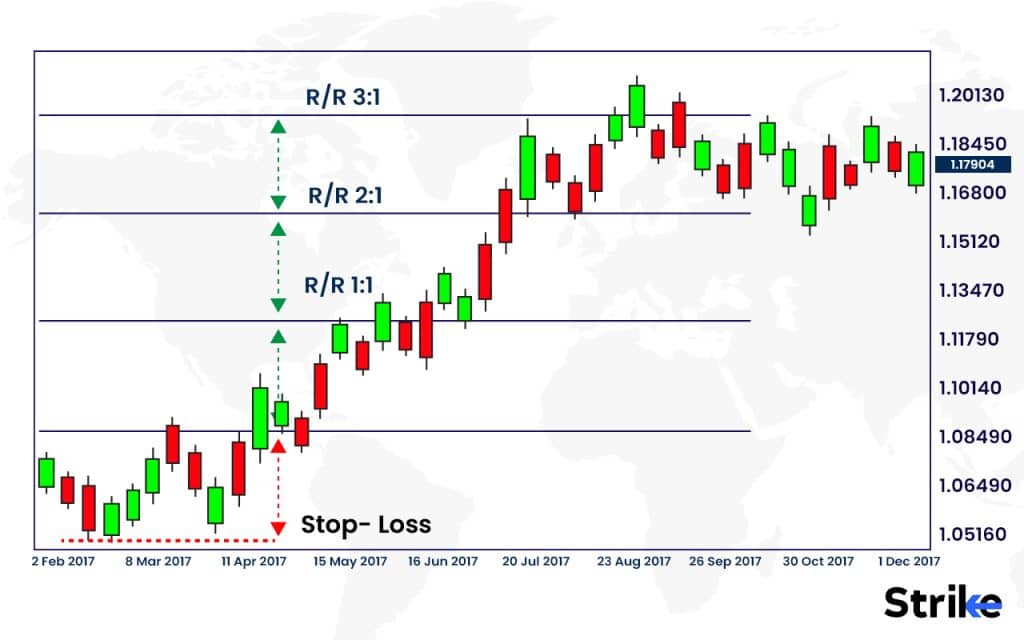
The risk reward ratio is a simple ratio that explains the relationship between the potential return an investment could give and the risk associated with the investment. Risk reward ratio helps traders gauge the risk associated with the investment. They will be able to compare the same with the return potential and then take a call on whether to invest/trade or not.
Risk reward ratio carries a simple calculation. It is calculated by dividing the projected returns with the expected loss figure. Understanding the risk reward ratio is important as it helps traders make better trade decisions.
What is the Risk Reward Ratio?
The risk reward ratio is a mathematical representation of potential returns compared to the risk associated with the investment. The risk reward ratio is calculated by dividing the expected return by the amount of risk involved, as measured by the standard deviation of returns. A higher risk reward ratio is considered better, as it indicates an investment has the potential for higher returns per unit of risk.
Here, the graphic shows two arrows pointing in opposite directions, representing the potential profit and potential loss for a trade. The upside arrow pointing up indicates the possible profit, while the downside arrow pointing down indicates the possible loss if the trade goes against you.
How do you calculate the Risk Reward Ratio?
Let’s look at an example where a trader is evaluating a potential long trade (buying) in Tata Motors DVR with the following details. Look at the image below.

Current Entry Price: Rs.673.70
Stop Loss: Rs. 677.40
Target Price: Rs.681.10
Now, let us calculate the risk-reward ratio Risk is the difference between the entry price and stop-loss.
Hence, Risk = Rs.677.40 – Rs.673.70 = Rs.3.70
Reward is the difference between the entry price and the assumed target price.
Hence, Reward = Rs.681.10 – Rs.673.70 = Rs.7.40
Risk-Reward Ratio = The reward divided by the risk.
Risk-Reward Ratio = Rs.7.40 / Rs.3.70 = 2
This trade offers a risk-reward ratio of 1:2. For every rupee the trader risks, there’s a potential to gain two rupees.
How to use the Risk Reward Ratio?
The best way to use the risk reward ratio in trading is to compare it to your risk tolerance and target ratio. Generally, a minimum 1:1 ratio is recommended, with higher ratios preferred for higher reward potential versus risk taken. Traders adjust stop losses and take profit levels to achieve an optimal risk reward ratio for each trade within their trading plan.
Having a minimum risk reward ratio for your trades is important for long-term profitability. Many experienced traders use at least a 1:1 minimum ratio, meaning the potential profit target is equal to or greater than the amount risked on the trade. More conservative traders use a 2:1 or 3:1 minimum ratio. Setting these parameters helps ensure you only take trades with favorable profit potential. The best risk-reward ratio for you depends largely on your risk tolerance. Aggressive traders may be comfortable with a 1:1 ratio, while conservative ones may prefer 3:1 or higher. Compare the ratio to your style and risk appetite before putting on trades.
It is sensible to have a diversified approach, with some trades at a lower ratio and others at a higher ratio. Higher reward trades can offset smaller losing trades over time. The key is managing trades and capital to allow staying in the game long term.
Why is the Risk Reward Ratio important?
Risk reward ratio is important because it helps traders quantify the potential reward versus risk for a trade. A favorable risk reward ratio, such as 2:1 or higher, provides a positive expectancy for a trade since the potential gain is greater than the potential loss. Analyzing risk reward ratios on trades is crucial for traders to have sound money management, determine appropriate trade sizing, and improve their overall chances of profitability.
The risk reward ratio also enables traders to compare reward potential between different trade opportunities. A trader can determine if a 2:1 or 3:1 reward potential is preferable over a 1:1 or lower ratio. Higher reward potential translates to greater profitability over many trades. Furthermore, the risk reward ratio guides traders in their account and trade sizing. Knowing the risk-reward parameters allows a trader to appropriately size positions to stay within proper risk management rules. Taking too much risk on trades with poor reward potential can lead to account wipeouts.
The risk reward ratio provides a mathematical way for traders to identify logical levels for their profit targets and stop losses. Without analyzing risk vs reward, traders might arbitrarily pick round numbers or set targets based on emotions. For example, a trader may simply place a profit target at +Rs.1000 and a stop at -Rs.500 without rhyme or reason. A more objective approach is to base targets and stops on previous support and resistance levels or the volatility of the instrument. For instance, A stock has swung between Rs.50 and Rs.60 over the past month, the trader could identify those price levels as potential profit and stop areas. This would create a favorable 2:1 risk reward scenario if the trader entered at Rs. 55.
What is a good Risk Reward Ratio?
1:3 is universally considered a good risk reward ratio. A ratio of 1:3 means the potential profit is 3 times the potential loss, so the reward is much higher than the risk. Conservative investors often look for risk/reward ratios of 1:2 or less, as they are willing to risk smaller potential losses for smaller potential gains. Aggressive investors are sometimes comfortable with risk/reward ratios of 1:5 or higher, taking on greater potential losses for the chance of much larger gains.
What is meant by a high Risk Reward Ratio?
A high risk reward ratio means that the potential reward from a trade or investment is much greater than the amount of risk involved. This is a desirable situation for investors because it provides the opportunity for large gains with limited downside.
What is meant by low Risk Reward Ratio?
A low risk reward ratio means the potential reward from a trade or investment is only slightly higher than the amount of risk involved. This is generally an unfavorable situation for investors because it provides limited upside potential while still having downside risk. Investors want to avoid setups that have a low probability of making more than 1-2x the amount risked.
What does a 2:1 Risk to Reward Ratio mean?
A 2:1 risk to reward ratio means the potential profit from a trade is twice as large as the potential loss. For example, in case the risk on a trade is Rs.100, then a 2:1 ratio means the profit target is Rs.200.
What does a 3:1 Risk to Reward Ratio mean?
A 3:1 risk to reward ratio is considered ideal for many traders. It means the potential profit from a trade is three times as large as the potential loss. For example, in case a trader risks Rs.100 on a trade, a 3:1 ratio means the profit target is Rs.300. This favourable ratio provides more upside potential versus downside risk on each trade, allowing profitable trades to cover losing ones over time. A 3:1 risk-reward ratio or higher is generally recommended for trading strategies.








![85 Common Stock Market Terminologies for Dummies [Updated List for 2025] 16 85 Common Stock Market Terminologies for Dummies [Updated List for 2025]](https://www.strike.money/wp-content/uploads/2025/04/Popular-Stock-Market-Terms-for-Beginners-Banner.png)










No Comments Yet.